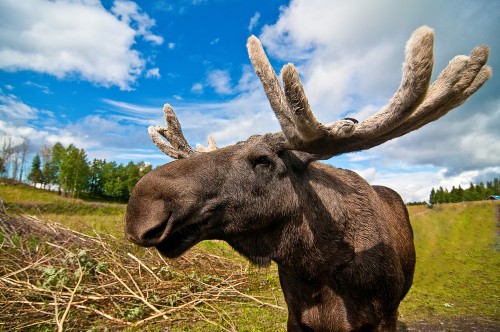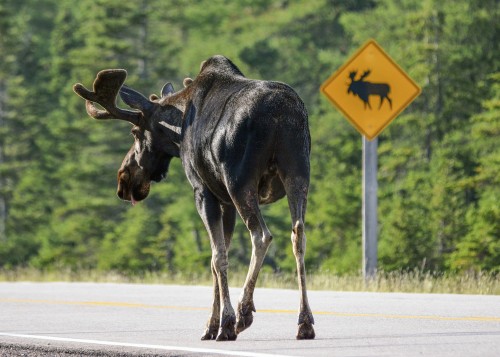“Did I ever tell you about the time I got charged by a moose?”
We were at the point in our camping trip where everyone was dusting off their close-encounters-with-wildlife stories.
“Now, Davis, don’t tell that story or we’re going to get into an argument,” warned his wife.
“She was downwind of the bear spray when I let it off,” explained Davis, not particularly apologetically.
Every Newfoundlander has a story or two about the danger of moose, the dominant ungulate on the island. There is roughly one moose for every three people there – the most intense moose density in the world – and the population continues to grow despite 22,000 being harvested yearly during hunting season.
Though bulls become curious and aggressive during rutting season in September, the biggest hazard is not of the charging, snorting variety.
Hit a deer with your car and you will likely be shaken up, traumatized, possibly injured. There will be damage to the vehicle. But if moose and the modern automobile had coevolved for thousands of years, they could not have been a combination better suited to kill motorists.
In the typical moose-vehicle collision, the moose’s legs – longer in the front than in the back, lending him that camel-like appearance – break on the bumper and grill. Then the whole 1000lbs of body weight clears the hood and slams through the windshield, crushing the front roof support beams and anyone in the front seats.
An average of 700 such accidents happen annually in Newfoundland, and it’s a wonder that only a couple of deaths result each year. Many any more victims are permanently disabled. Moose, like bats and mosquitoes, are crepuscular – most active at dawn and dusk – and these are also the times when they are virtually invisible to motorists. Most accidents happen along straight sections on clear nights, presumably because easy conditions make motorists relax.
A class action suit is in the works against the provincial government for failing to protect its citizens from the moose. This isn’t an act of God or nature, you see, but a direct result of the government’s import of moose for food in 1878 and again in 1904, half a century before the British colony joined Canada. From just six introduced moose, there are now more than 120,000 throughout the island, causing – according to the Statement of Claim – a public nuisance. The claim goes so far as to say that the government has turned Crown land over to the pasturing of an invasive species.
There might have been a natural predator ready to keep the population in check – the Newfoundland wolf – but this was driven into extinction by bounty-hunting farmers and habitat destruction just as the moose were being brought in.
There’s talk of underpasses to keep the moose off the roads. Trouble is, it’s not as if they just stumble onto the highway on their way to somewhere else. Roads are an oasis of relief from the incessant plague of flies in the woods in summer and from deep snow in winter.
Newfoundland’s coastal highways are long and remote, but wildlife fencing is an option for select problem areas. The government doesn’t seem to think it would be publicly acceptable to drastically raise the number of moose hunting tags they issue – the only way to make a real dent in the population – so they spend their time on measures they know don’t work, like highway signage and brush clearing.
Newfoundlanders are a famously warmhearted people, but I wouldn’t assume they would object, at this point, to a more drastic cull. When the Ontario city of Thunder Bay recently introduced a deer bow-hunt within city limits, there was a surprising lack of opposition. People were just so fed up with being overrun with deer, perceived as a Lyme disease threat as well as a collision hazard.
Archery classes have sprung up so that citizens can practice. They have to stay a minimum of 75 meters from the nearest dwelling and shoot from an elevated tree stand. The nearby town of Kenora, Ontario, soon followed suit with their own bow hunt. In Newfoundland, the prevailing thought, no matter who is responsible for this predicament, may soon be: It’s them or us.

